
Gothic Revival architecture in Canada
Encyclopedia

The Gothic Revival period lasted longer and was more thoroughly embraced in Canada than in either Britain or the United States, only falling out of style in the 1930s. The late nineteenth and early twentieth century was also the period when many major Canadian institutions were founded. Throughout Canada many of the most prominent religious, civic, and scholastic institutions are housed in Gothic Revival style buildings. In the 1960s and 1970s several scholars, most notably Alan Gowans, embraced Canadian Gothic Revival architecture as one of the nation's signature styles and as an integral part of Canadian nationalism
Canadian nationalism
Canadian nationalism is a term which has been applied to ideologies of several different types which highlight and promote specifically Canadian interests over those of other countries, notably the United States...
. While largely abandoned in the modernist
Modern architecture
Modern architecture is generally characterized by simplification of form and creation of ornament from the structure and theme of the building. It is a term applied to an overarching movement, with its exact definition and scope varying widely...
period, several postmodern
Postmodern architecture
Postmodern architecture began as an international style the first examples of which are generally cited as being from the 1950s, but did not become a movement until the late 1970s and continues to influence present-day architecture...
architects have embraced Canada's neo-Gothic past.
Introduction to Canada
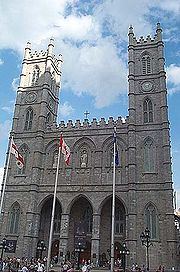
Gothic architecture
Gothic architecture is a style of architecture that flourished during the high and late medieval period. It evolved from Romanesque architecture and was succeeded by Renaissance architecture....
is a name given in retrospect to many of the major projects of the High Middle Ages
High Middle Ages
The High Middle Ages was the period of European history around the 11th, 12th, and 13th centuries . The High Middle Ages were preceded by the Early Middle Ages and followed by the Late Middle Ages, which by convention end around 1500....
. As this period covered the 13th and 14th centuries, there are no authentic Gothic buildings in Canada. The style was quite out of favour in the seventeenth century when Europeans first began erecting structures in Canada, and the style is absent from the early settlements in New France
New France
New France was the area colonized by France in North America during a period beginning with the exploration of the Saint Lawrence River by Jacques Cartier in 1534 and ending with the cession of New France to Spain and Great Britain in 1763...
and the Maritimes.
In the eighteenth century a growing spirit of Romanticism
Romanticism
Romanticism was an artistic, literary and intellectual movement that originated in the second half of the 18th century in Europe, and gained strength in reaction to the Industrial Revolution...
and interest in the Medieval past led to a revival of Gothic styles in Britain. The style made its way to Canada in the early nineteenth century. One of the first appearances is in an 1811 proposal by Jeffry Wyatt for a new legislature in Quebec City
Quebec City
Quebec , also Québec, Quebec City or Québec City is the capital of the Canadian province of Quebec and is located within the Capitale-Nationale region. It is the second most populous city in Quebec after Montreal, which is about to the southwest...
. One of the first major Gothic Revival structures in Canada was Notre-Dame Basilica in Montreal
Montreal
Montreal is a city in Canada. It is the largest city in the province of Quebec, the second-largest city in Canada and the seventh largest in North America...
, which was designed in 1824 by the Irish-American James O'Donnell
James O'Donnell
James O'Donnell may refer to:*James O'Donnell , 19th century United States Representative from Michigan*James O'Donnell , American sports promoter and founder of the NFL's Cleveland Tigers...
. The largest church in North America upon its completion, it was one of the first architectural works of international note to be built in Canada. It was also one of the first Catholic Gothic Revival structures, as the movement would not spread from Britain to France and continental Europe until several years later. As the most prominent church in the colony its form was much imitated by local church builders, who constructed miniature versions of the basilica across Quebec.
Protestants also embraced the style. As early as the late eighteenth century certain Gothic elements had appeared in a church in Nova Scotia, though the Georgian
Georgian architecture
Georgian architecture is the name given in most English-speaking countries to the set of architectural styles current between 1720 and 1840. It is eponymous for the first four British monarchs of the House of Hanover—George I of Great Britain, George II of Great Britain, George III of the United...
and Neo-classical styles remained dominant for several decades. The first stone neo-Gothic structure in the Maritimes is St. John's Church in Saint John, New Brunswick
Saint John, New Brunswick
City of Saint John , or commonly Saint John, is the largest city in the province of New Brunswick, and the first incorporated city in Canada. The city is situated along the north shore of the Bay of Fundy at the mouth of the Saint John River. In 2006 the city proper had a population of 74,043...
. It dates to 1824, the same year work began on Notre-Dame. In the 1830s and 1840s four prominent neo-Gothic Churches were built in Quebec City
Quebec City
Quebec , also Québec, Quebec City or Québec City is the capital of the Canadian province of Quebec and is located within the Capitale-Nationale region. It is the second most populous city in Quebec after Montreal, which is about to the southwest...
, representing each of that city's major Protestant denominations.
By the 1840s the Gothic Revival style had become virtually universal among Anglicans and used for most other Christian denominations as well. As in much of the English speaking world the lancet windows and buttresses of the Gothic Revival style soon became permanently associated in most people's mind with ecclesiastical buildings. It was soon also embraced for secular purposes as well, such as government buildings and universities. Canadian universities modeled themselves on the great British universities, Oxford and Cambridge, and this extended to embracing the Gothic architecture used in their construction. Two of the first Gothic Revival colleges were Trinity College
University of Trinity College
The University of Trinity College, informally referred to as Trin, is a college of the University of Toronto, founded in 1851 by Bishop John Strachan. Trinity was intended by Strachan as a college of strong Anglican alignment, after the University of Toronto severed its ties with the Church of...
in Toronto and Bishop's University
Bishop's University
Bishop's University is a predominantly undergraduate university in Lennoxville, Sherbrooke, Quebec, Canada. Bishop's is one of three universities in the province of Quebec that teach primarily in the English language...
in Quebec.The gothic revival architecture became very popular throughout Canada and the U.S and has been known for years
Victorian High Gothic

One of the most important examples of this style anywhere in the world were the Parliament Buildings
Parliament Hill
Parliament Hill , colloquially known as The Hill, is an area of Crown land on the southern banks of the Ottawa River in downtown Ottawa, Ontario. Its Gothic revival suite of buildingsthe parliament buildings serves as the home of the Parliament of Canada and contains a number of architectural...
designed by Thomas Fuller
Thomas Fuller (architect)
Thomas Fuller was a Canadian architect.He was born in Bath, Somerset , where he trained as an architect. Living in Bath and London he did a number of projects. In 1845 he left for Antigua, where he spent two years working on a new cathedral before emigrating to Canada in 1857...
. While the style and design of the building is unquestionably Gothic, it resembles no building constructed during the Middle Ages. The forms were the same, but their arrangement was uniquely modern. The Parliament Buildings also departed from Medieval models by integrating a variety of eras and styles of Gothic architecture, including elements of Gothic architecture from Britain, France, the Low Countries, and Italy all in one building.
In his Hand Book to the Parliamentary and Departmental Buildings, Canada (1867), Joseph Bureau wrote, "The style of the Buildings is the Gothic of the 12th and 13th Centuries, with modification to suit the climate of Canada. The ornamental work and the dressing round the windows are of Ohio sandstone. The plain surface is faced with a cream-colored sandstone of the Potsdam formation, obtained from Nepean, a few miles from Ottawa. The spandrils of the arches, and the spaces between window-arches and the sills of the upper windows, are filled up with a quaint description of stonework, composed of stones of irregular size, shape and colour, very neatly set together."
This style was also embraced for religious architecture. In most towns in Ontario, and also in many parts of the newly settled west and the Maritimes, elaborate High Gothic churches were built. Unlike in the earlier era, the French Catholic church in Quebec did not embrace this style. During this period the church leadership favoured a neo-baroque
Neo-baroque
The Baroque Revival or Neo-baroque was an architectural style of the late 19th century. The term is used to describe architecture which displays important aspects of Baroque style, but is not of the Baroque period proper—i.e., the 17th and 18th centuries.Some examples of Neo-baroque architecture:*...
style more closely linked to the architecture of New France
New France
New France was the area colonized by France in North America during a period beginning with the exploration of the Saint Lawrence River by Jacques Cartier in 1534 and ending with the cession of New France to Spain and Great Britain in 1763...
.
The Victorian High Gothic period also saw a willingness to combine the neo-Gothic with other styles. Two important examples of a mix between Gothic and Romanesque styles are University College
University College, University of Toronto
University College is a constituent college of the University of Toronto, created in 1853 specifically as an institution of higher learning free of religious affiliation. It was the founding member of the university's modern collegiate system, and its secularism contrasted with contemporary...
in Toronto and the British Columbia Parliament Buildings
British Columbia Parliament Buildings
The British Columbia Parliament Buildings are located in Victoria, British Columbia, Canada and are home to the Legislative Assembly of British Columbia....
. Variations on the neo-Gothic style developed in Britain were also imported to Canada. The Scottish baronial style
Scottish baronial style
The Scottish Baronial style is part of the Gothic Revival architecture style, using stylistic elements and forms from castles, tower houses and mansions of the Gothic architecture period in Scotland, such as Craigievar Castle and Newark Castle, Port Glasgow. The revival style was popular from the...
was employed by Chief Dominion Architect David Ewart
David Ewart
David Ewart was a Canadian architect who served as Chief Dominion Architect from 1896 to 1914.As chief government architect he was responsible for many of the federal buildings constructed in this period...
to create a number of castle like structures in Ottawa. New materials were also incorporated. Cast iron allowed stronger structures with thinner supporting walls to be built, while some recreated gothic forms in brick, rather than the traditional stone or wood.
One style that rose to special prominence was the Château Style of Canada's grand railway hotels
Canada's grand railway hotels
Canada’s railway hotels are a series of grand hotels across the country, each a local and national landmark, and most of which are icons of Canadian history and architecture. Each hotel was originally built by the Canadian railway companies, or the railways acted as a catalyst for the hotel’s...
, also known as Railway Gothic. This style first appeared in the late nineteenth century with grandiose railway hotels such as the Château Frontenac
Château Frontenac
The Château Frontenac, currently known as Fairmont Le Château Frontenac, is a grand hotel in Quebec City, Quebec, Canada. It was designated a National Historic Site of Canada in 1980...
and Banff Springs Hotel
Banff Springs Hotel
The Fairmont Banff Springs or simply the Banff Springs Hotel is a former railway hotel constructed in Scottish Baronial style located in Banff National Park, Alberta, Canada. The original hotel, designed by American architect Bruce Price, was built between spring of 1887 and 1888 by the Canadian...
. It mixed Gothic Revival with elements borrowed from the castles of the Loire
Loire
Loire is an administrative department in the east-central part of France occupying the River Loire's upper reaches.-History:Loire was created in 1793 when after just 3½ years the young Rhône-et-Loire department was split into two. This was a response to counter-Revolutionary activities in Lyon...
in France.
Architectural dominance
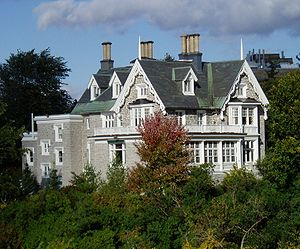
There are other reasons the Gothic styles became so widespread in Canada. The steep roofs and thick stone walls were well suited to Canada's northern climate. In the United States architects liked to link their republic to those of Ancient Greece and Rome through the neo-classical style. Canada's Loyalists had no such leanings, and the English-Canadian elite was strongly Anglophilic and monarchist. Gothic architecture was seen as symbolic of this. In the late nineteenth century as Canada began to see an influx of Southern and Eastern European immigrants, the nativist backlash also embraced Gothic Revival architecture as emblematic of Canada's identity as a homeland for the "northern race." In French Canada the civic and religious authorities of the nineteenth and early twentieth century also embraced a strident conservatism.
While during this period the Gothic Revival style was almost universal among Christian religious buildings, it was less so among secular structures. Other revival styles were also popular. Romanesque Revival buildings were popular, as were neo-classical structures. No provincial legislature copied the style of the Parliament buildings. Even in Ottawa several federal government buildings of this period embraced other styles.
Pure Gothic forms were mostly unsuited to the day to day requirements of residential and commercial properties; however, neo-Gothic ornamentation and principles were successfully adapted to these uses, and these structures became quite popular in the late nineteenth and early twentieth century. In rural areas the Gothic Cottage was immensely popular until well into the twentieth century. Neighbourhoods that grew during this period, such as Cabbagetown and the Annex
The Annex
The Annex is a neighbourhood in downtown Toronto, Ontario, Canada. The traditional boundaries of the neighbourhood are north to Dupont Street, south to Bloor Street, west to Bathurst Street and east to Avenue Road...
in Toronto, have many examples of houses that incorporate neo-Gothic elements. This includes a highly vertical emphasis on the structure; ornate decorations on the gable
Gable
A gable is the generally triangular portion of a wall between the edges of a sloping roof. The shape of the gable and how it is detailed depends on the structural system being used and aesthetic concerns. Thus the type of roof enclosing the volume dictates the shape of the gable...
s, often incorporating classic Gothic trefoil
Trefoil
Trefoil is a graphic form composed of the outline of three overlapping rings used in architecture and Christian symbolism...
forms; and lancet windows and door frames. In rural Ontario the ubiquitous Ontario Cottage
Ontario Cottage
The Ontario Cottage is a style of house that was commonly built in 19th century Ontario, Canada. The Ontario Cottage became popular in the 1820s and remained a common style until the end of that century. They were mainly built in rural and small town areas, less so in larger cities...
was often adorned with Gothic elements.
Modern Gothic
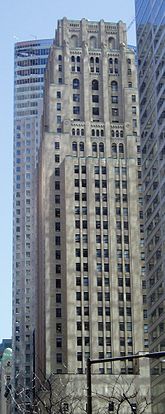
Art Deco
Art deco , or deco, is an eclectic artistic and design style that began in Paris in the 1920s and flourished internationally throughout the 1930s, into the World War II era. The style influenced all areas of design, including architecture and interior design, industrial design, fashion and...
came to prominence. However, this was much less true in Canada. Gothic Revival architecture continued to be one of the most important building styles well into the 1940s, though often in highly modified and original forms. Just before the First World War Toronto saw work begin on three of its best known neo-Gothic structures, Casa Loma
Casa Loma
Casa Loma is a Gothic Revival style house in midtown Toronto, Ontario, Canada, that is now a museum and landmark. It was originally a residence for financier Sir Henry Mill Pellatt. Casa Loma was constructed over a three-year period from 1911–1914. The architect of the mansion was E. J...
, the CHUM-City Building
CHUM-City Building
299 Queen Street West, also known as Bell Media Queen Street, is an office and studio complex located at the intersection of Queen Street West and John Street in Downtown Toronto, Ontario, Canada. Currently the corporate head office of Bell Media the building previously served as the headquarters...
, and Hart House. While the three buildings were erected for completely different purposes, and a very distinct in style, they are all clearly Gothic in inspiration.
In the years after the First World War, when the Gothic Revival was being supplanted in most of the world, Canada was also experiencing greatly strengthened Canadian nationalism
Canadian nationalism
Canadian nationalism is a term which has been applied to ideologies of several different types which highlight and promote specifically Canadian interests over those of other countries, notably the United States...
. For the first time the Canadian political and cultural elite began to seek a path distinct from that being followed in the United Kingdom and United States. As so many notable Canadian structures were Gothic Revival in style it became closely linked to Canadian identity, and was embraced by the new Canadian nationalism.
Perhaps the most important Gothic Revival structure was the new Centre Block of the Canadian Parliament. The Gothic Revival monument of Thomas Fuller was destroyed by a fire in 1917. Despite the half a century that had elapsed since the first parliament was built, the Gothic Revival style was still the obvious choice to the Canadian Government. The new building had several important differences from the old one, most notably the new Peace Tower
Peace Tower
The Peace Tower is a focal bell and clock tower, sitting on the central axis of the Centre Block of the Canadian parliament buildings in Ottawa, Ontario. The present incarnation replaced the Victoria Tower after the latter burned down in 1916, along with most of the Centre Block...
. The federal government continued building in the Gothic Revival style, of which long serving Prime Minister William Lyon Mackenzie King
William Lyon Mackenzie King
William Lyon Mackenzie King, PC, OM, CMG was the dominant Canadian political leader from the 1920s through the 1940s. He served as the tenth Prime Minister of Canada from December 29, 1921 to June 28, 1926; from September 25, 1926 to August 7, 1930; and from October 23, 1935 to November 15, 1948...
was a strong supporter, for several decades. As the federal government expanded, two major civil service office buildings were built in the Gothic style just to the west of Parliament Hill in the 1930s.
After the First World War some of the most prominent Gothic Revival structures were constructed by Canada's universities, in a style that is often known as Collegiate Gothic. The newer universities of western Canada, such as the University of British Columbia
University of British Columbia
The University of British Columbia is a public research university. UBC’s two main campuses are situated in Vancouver and in Kelowna in the Okanagan Valley...
and University of Saskatchewan
University of Saskatchewan
The University of Saskatchewan is a Canadian public research university, founded in 1907, and located on the east side of the South Saskatchewan River in Saskatoon, Saskatchewan, Canada. An "Act to establish and incorporate a University for the Province of Saskatchewan" was passed by the...
, turned to traditional styles as they underwent large expansions. The older universities of Ontario also built several new Gothic Revival Structures.
Gothic Revival finally almost completely disappeared after the Second World War, as Canada embraced Modern Architecture
Modern architecture
Modern architecture is generally characterized by simplification of form and creation of ornament from the structure and theme of the building. It is a term applied to an overarching movement, with its exact definition and scope varying widely...
and the International Style
International style (architecture)
The International style is a major architectural style that emerged in the 1920s and 1930s, the formative decades of Modern architecture. The term originated from the name of a book by Henry-Russell Hitchcock and Philip Johnson, The International Style...
. This was motivated by the prevailing fashion of the period, but also by economics and technology. The stark new structures of steel and glass were vastly cheaper than the often ornate stone constructions of the neo-Gothic style. The style thus almost completely disappeared.
The rise of postmodern architecture
Postmodern architecture
Postmodern architecture began as an international style the first examples of which are generally cited as being from the 1950s, but did not become a movement until the late 1970s and continues to influence present-day architecture...
, with its interest in history and place, has seen the occasional reintegration of Gothic Revival styles. One example is Massey College
Massey College
Massey College is a postgraduate residential college at the University of Toronto, established in 1963 with an endowment by the Massey Foundation. Similar to All Souls College, Oxford, members of Massey College are nominated from the university community, and are elected by and as fellows of the...
at the University of Toronto
University of Toronto
The University of Toronto is a public research university in Toronto, Ontario, Canada, situated on the grounds that surround Queen's Park. It was founded by royal charter in 1827 as King's College, the first institution of higher learning in Upper Canada...
. Its materials and the elements of its design are fully modern, however the form and arrangement of those materials directly quotes from the Gothic Revival structures on campus. Another is the Windsor Arms Hotel
Windsor Arms Hotel
The Windsor Arms is a boutique hotel in Toronto, Ontario, Canada. It is located at 18 St. Thomas St. in the heart of the Yorkville neighbourhood. The hotel includes Club 22, Court Yard Cafe and a Spa....
, also in Toronto. It is a modern Gothic styled skyscraper built on the base of an older Gothic Revival structure from the turn of the century.
List of Gothic Revival buildings in Canada
Prominent Gothic Revival buildings across Canada listed by city.St John's
| Building | Function | Year | Image |
|---|---|---|---|
| Cathedral of St. John the Baptist Cathedral of St. John the Baptist (St. John's) The Cathedral of St. John the Baptist is located in the city of St. John's, Newfoundland. This parish in the Diocese of Eastern Newfoundland and Labrador was founded in 1699 in response to a petition drafted by the Anglican townsfolk of St. John's and sent to the Bishop of London, the Rt. Rev.... |
Church | 1847 |  |
| St. Patrick's Church St. Patrick's Church (St. John's) Saint Patrick's Church is a Roman Catholic church in St. John's, Newfoundland, Canada.-History:The cornerstone of St. Patrick's Church was laid on September 17, 1855, by Bishop John T. Mullock and other distinguished clergy from Canada and the United States. American financier, Cyrus Field,... |
Church | 1855 | 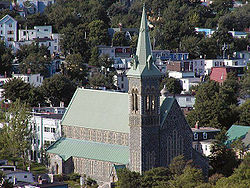 |
Halifax
| Building | Function | Year | Image |
|---|---|---|---|
| St. Matthew's United Church St. Matthew's United Church (Halifax) St. Matthew's United Church is a United Church of Canada church in downtown Halifax, Nova Scotia. The church was founded at the same time as the original colony in 1749 as a home for the various groups of dissenting Protestants who did not follow the Church of England. It originally met Sunday... |
Church | 1857 | 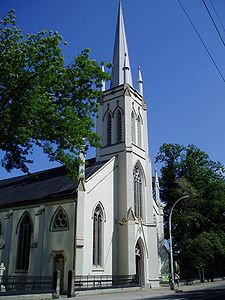 |
| St. Mary's Basilica St. Mary's Basilica (Halifax) St. Mary's Cathedral Basilica is a Catholic cathedral located in downtown Halifax, Nova Scotia, Canada. The facade and spire are entirely of local granite, and its architectural design is said to have been inspired by Saint Martin in the Fields in London. Construction began in 1820 and it was... |
Church | 1899 |  |
Quebec City
| Building | Function | Year | Image |
|---|---|---|---|
| Château Frontenac Château Frontenac The Château Frontenac, currently known as Fairmont Le Château Frontenac, is a grand hotel in Quebec City, Quebec, Canada. It was designated a National Historic Site of Canada in 1980... |
Hotel | 1893 | 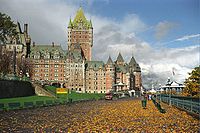 |
Montreal
| Building | Function | Year | Image |
|---|---|---|---|
| Notre-Dame de Montréal Basilica | Church | 1888 |  |
| St. Patrick's Basilica | Church | 1847 |  |
| Christ Church Cathedral Christ Church Cathedral (Montreal) Christ Church Cathedral is an Anglican Gothic Revival cathedral in Montreal, Quebec, Canada, the seat of the Anglican Diocese of Montreal. It is located at 635 Saint Catherine Street West, between Union Avenue and University Street. It is situated on top of the Promenades Cathédrale underground... |
Church | 1859 | 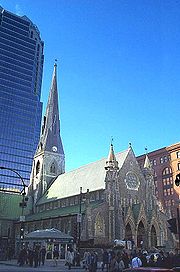 |
Ottawa
| Building | Function | Year | Image |
|---|---|---|---|
| Houses of Parliament Parliament Hill Parliament Hill , colloquially known as The Hill, is an area of Crown land on the southern banks of the Ottawa River in downtown Ottawa, Ontario. Its Gothic revival suite of buildingsthe parliament buildings serves as the home of the Parliament of Canada and contains a number of architectural... |
Government buildings | 1865 (Centre Block rebuilt 1920) |
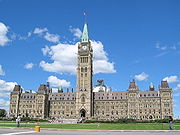 |
| Notre-Dame Cathedral Basilica Notre-Dame Cathedral Basilica The Notre-Dame Cathedral Basilica is an ecclesiastic basilica in Ottawa, Canada located on 375 Sussex Drive in the Lower Town neighbourhood. It was designated a National Historic Site of Canada in 1990.-History and architecture:... |
Church | 1846 | 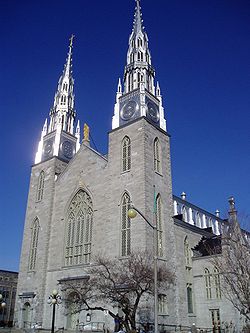 |
| Earnscliffe Earnscliffe Earnscliffe is a Victorian manor in Ottawa, Ontario. It is currently home of the British High Commissioner to Canada, and it was previously home to Canada's first Prime Minister, Sir John A. Macdonald. The manor overlooks the Ottawa River just east of the Macdonald-Cartier Bridge. It is located... |
Residence | 1855 |  |
| St. Bartholomew's Anglican Church St. Bartholomew's Anglican Church (Ottawa) St. Bartholomew's Anglican Church is an Anglican Church in Ottawa, Canada. The parish was founded in 1866 and the building completed in 1868. Its architect is uncertain but believed to have been Thomas Seaton Scott who designed a number of other prominent Ottawa structures... |
Church | 1868 | 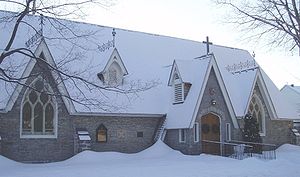 |
| St. Andrew's Presbyterian Church St. Andrew's Presbyterian Church (Ottawa) St. Andrew's Presbyterian Church is the oldest Presbyterian church in Ottawa, Canada.-Creation:St. Andrews is Ottawa's oldest Protestant [Presbyterian Church in Canada] congregation, with the original church opening in 1828... |
Church | 1872 | 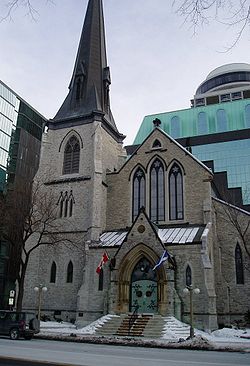 |
| Christ Church Cathedral Christ Church Cathedral (Ottawa) Christ Church Cathedral is the Anglican cathedral in Ottawa, Ontario, Canada. The church is located in the northwest section of the city's downtown at the western end of Sparks Street at the top of a promontory looking down to the Ottawa River.-Beginnings:... |
Church | 1872 |  |
| Lisgar Collegiate Institute Lisgar Collegiate Institute Lisgar Collegiate Institute is an Ottawa-Carleton District School Board secondary school in Ottawa, Ontario, Canada.Lisgar Collegiate Institute, one of the country's best regarded public schools, is located in downtown Ottawa by the Rideau Canal and is only a few blocks from Canada's Parliament Hill... |
School | 1873 | 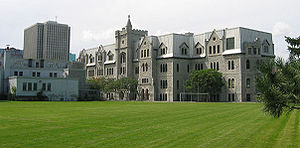 |
| Ottawa Normal School Ottawa Normal School The Heritage Building is today part of Ottawa City Hall. It was originally built in 1874 as Ottawa Normal School and served as a teacher's college. The Gothic Revival building stands at Elgin Street and Lisgar and several extensions were added to the rear of the building.It was part of Ontario's... |
College | 1874 | 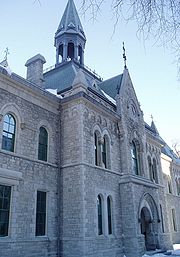 |
| St. Patrick's Basilica St. Patrick's Basilica (Ottawa) St. Patrick's Basilica, located at 281 Nepean Street , is the oldest English-speaking Roman Catholic Church in Ottawa, Ontario.-History:The parish was founded in 1855... |
Church | 1875 |  |
| St. Alban's Anglican Church St. Alban's Anglican Church (Ottawa) St. Albans Anglican Church is an Anglican parish in the Sandy Hill neighbourhood of Ottawa, Canada. It is Ottawa's oldest surviving church building and one of its most historic. The original Gothic Revival design for the church was done by Thomas Fuller, who also designed Canada's original... |
Church | 1877 |  |
| First Baptist Church First Baptist Church (Ottawa) First Baptist Church is a prominent Baptist church in downtown Ottawa, Canada. It is part of the Baptist Convention of Ontario and Quebec. It was designed by James Mather.The church was first founded in 1857, the first Baptist congregation in Ottawa... |
Church | 1877 | 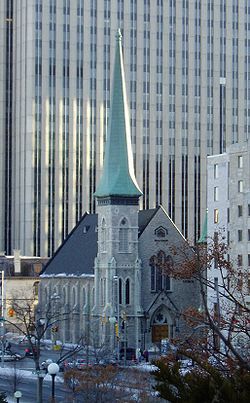 |
| Canadian Museum of Nature Canadian Museum of Nature The Canadian Museum of Nature is a natural history museum in Ottawa, Ontario, Canada. Its collections, which were started by the Geological Survey of Canada in 1856, include all aspects of the intersection of human society and nature, from gardening to gene-splicing... |
Museum | 1905 |  |
| Glebe-St. James United Church Glebe-St. James United Church Glebe St. James United Church, located in Ottawa's Glebe neighbourhood, was formed in 1965 from a merger of the Glebe and St. James congregations... |
Church | 1905 | 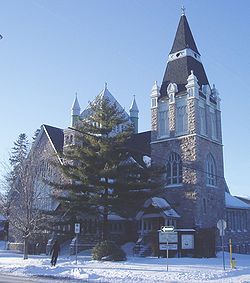 |
| McLeod-Stewarton United Church McLeod-Stewarton United Church Centretown United Church is an historic church located in Ottawa, Canada at 507 Bank Street at Argyle in the Centretown area. It was built in 1906 as the Stewarton Presbyterian Church in 1906 using Gothic Revival architecture under the architecture of Moses Chamberlain Edey, Centretown United... |
Church | 1906 | 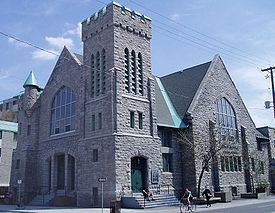 |
| MacKay United Church MacKay United Church MacKay United Church is a United Church of Canada church in the New Edinburgh neighbourhood of Ottawa, Canada. The church was founded in 1875 on land donated by William MacKinnon, grandson of Thomas McKay, and the founder of New Edinburgh and namesake of the church. The building was expanded in... |
Church | 1910 |  |
| First United Church First United Church (Ottawa) First United Church is a United Church of Canada congregation in Ottawa, Canada. One of Ottawa's oldest congregations, the church formed in 1846. In the middle of the 19th century, that church was the site of the first mixed race marriage in Canada. It was originally Congregationalist, but joined... |
Church | 1911 |  |
| Connaught Building Connaught Building The Connaught Building is a historic office building in Ottawa, Canada, owned by Public Works and Government Services Canada. It is located at 555 MacKenzie Street just south of the American Embassy... |
Office | 1916 |  |
| St. Matthew's Anglican Church | Church | 1930 | 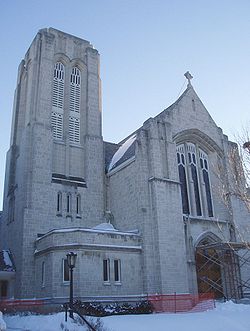 |
| Confederation Building (Ottawa) Confederation Building (Ottawa) The Confederation Building is a gothic revival office building in Ottawa, Canada. Located just west of the Parliament Buildings at Bank and Wellington Streets, it is generally considered part of Parliament Hill. Originally the land where the Confederation Building, and also the Supreme Court of... |
Office | 1931 |  |
| Blessed Sacrament Catholic Church Blessed Sacrament Catholic Church (Ottawa) Blessed Sacrament Catholic Church is a Catholic church in the Glebe neighbourhood of Ottawa, Ontario, Canada. The parish was founded on March 25, 1913, with the first building being a simple chapel. When the current building opened in 1932, its plain design and lack of ornamentation caused local... |
Church | 1932 | 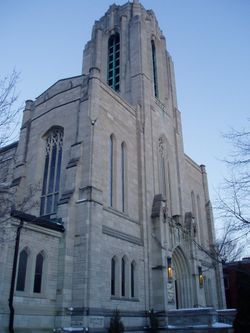 |
| Knox Presbyterian Church Knox Presbyterian Church (Ottawa) Knox Presbyterian Church is a Presbyterian Church in Ottawa, Ontario, Canada. It is named after John Knox, a founder of Presbyterianism in Scotland.It was founded as a result of the split within the congregation of St... |
Church | 1932 | 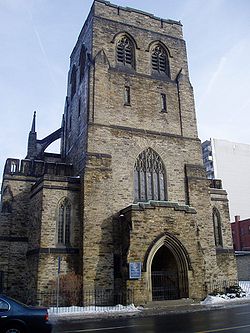 |
| Justice Building Justice Building The Justice Building in Ottawa was previously home to the Department of Justice , and now houses offices of Members of Parliament. It is similar in design as the Confederation Building, to which it is just west.... |
Office | 1938 |  |
Kingston
| Building | Function | Year | Image |
|---|---|---|---|
| Mackenzie Building, Royal Military College of Canada Royal Military College of Canada The Royal Military College of Canada, RMC, or RMCC , is the military academy of the Canadian Forces, and is a degree-granting university. RMC was established in 1876. RMC is the only federal institution in Canada with degree granting powers... |
school | 1922 |  |
Toronto
| Building | Function | Year | Image |
|---|---|---|---|
| Cathedral Church of St. James Cathedral Church of St. James (Toronto) Cathedral Church of St. James in Toronto, Canada is the home of the oldest congregation in the city. The parish was established in 1797. The Cathedral was begun in 1850 and completed in 1853, was at the time one of the largest buildings in the city... |
Church | 1844 |  |
| St. Michael's Cathedral St. Michael's Cathedral, Toronto St. Michael's Cathedral is the Roman Catholic cathedral of the Roman Catholic Archdiocese of Toronto, Canada, and one of the oldest churches in the city. It is located at 200 Church Street in Toronto's Garden District. St. Michael's was designed by William Thomas, designer of eight other churches... |
Church | 1845 | 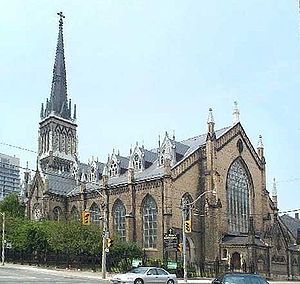 |
| Metropolitan United Church Metropolitan United Church Metropolitan United Church is a large neo-Gothic church in downtown Toronto, Canada. It is one of the largest and most prominent churches of the United Church of Canada. It is located on Queen Street East at the corner of Church Street in Toronto's Garden District.-History:The congregation,... |
Church | 1872 |  |
| 1 Spadina Crescent 1 Spadina Crescent 1 Spadina Crescent is an academic building of the University of Toronto in Toronto, Ontario, Canada, situated in the centre of a roundabout of Spadina Avenue, north of College Street. Its location provides a picturesque vista looking north up Spadina Avenue; it is an axial view terminus for Spadina... |
University | 1875 |  |
| St. Andrew's Evangelical Lutheran Church (Toronto) St. Andrew's Evangelical Lutheran Church (Toronto) St. Andrew's Evangelical Lutheran Church is an Evangelical Lutheran church in downtown Toronto serving the Latvian and Estonian population of Toronto. It is home to two congregations: St. Andrew's Evangelical Lutheran Estonian and St. Andrew's Evangelical Lutheran Latvian.The church was originally... |
Church | 1878 |  |
| Church of the Redeemer Church of the Redeemer (Toronto) The Church of the Redeemer is an Anglican church in Toronto, Canada. The small church is prominently located at the intersection of Bloor Street and Avenue Road, near the University of Toronto. It was founded in 1871 when the area was still on the fringe of the city... |
Church | 1879 | 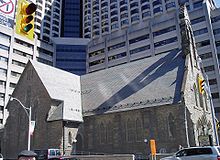 |
| College Street United Church College Street United Church College Street United Church is a United Church of Canada church at the corner of College and Bathurst Streets in Toronto, Canada. The large church was built in 1885 as College Street Presbyterian and could hold 1200 worshippers, under founding minister Alexander Gilray , and Robert Balmer Cochrane... |
Church | 1885 | 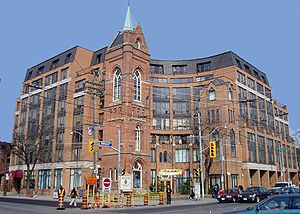 |
| Toronto Chinese Baptist Church Toronto Chinese Baptist Church The Toronto Chinese Baptist Church is a Baptist church serving the Chinese-Canadian community of Toronto, Canada. It was originally built as Beverley Street Baptist Church in 1886 by William McMaster and is a designated historic building... |
Church | 1886 | 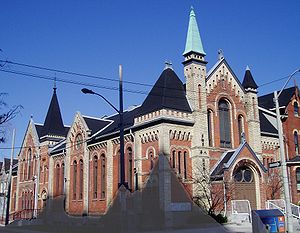 |
| Bathurst Street Theatre Bathurst Street Theatre The Bathurst Street Theatre is a theatre in Toronto, Ontario, that is housed in a former church. The Gothic revival building is located at 736 Bathurst Street at Lennox, one traffic light to the south of Bloor Street, Honest Ed's, the Bathurst Street Subway Station, and across Bathurst from... |
Church | 1888 | 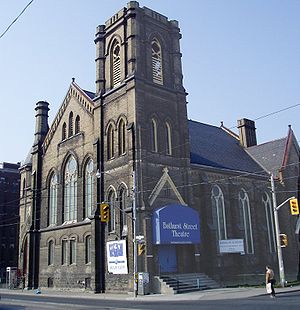 |
| Trinity-St. Paul's United Church Trinity-St. Paul's United Church Trinity-St. Paul's United Church is a church belonging to the United Church of Canada in Toronto, Ontario. It is located at 427 Bloor Street West, just west of Spadina Avenue. The church is formed of a mix of three different former congregations and houses a fourth.Today, Trinity-St. Paul's has a... |
Church | 1889 |  |
| Bloor Street United Church Bloor Street United Church Bloor Street United Church is a United Church of Canada church located at 300 Bloor Street West in downtown Toronto, near the intersection with Huron Street. It is just north of the University of Toronto, and between the Spadina and St. George Subway Stations.As with many of the downtown Toronto... |
Church | 1890 |  |
| Knox Presbyterian Church Knox Presbyterian Church (Toronto) Knox Presbyterian Church is a Presbyterian church in downtown Toronto, Canada.-History:In 1820 the first Presbyterian congregation in Toronto was formed, and after the donation of land from Jessie Ketchum, built a church on Richmond Street... |
Church | 1909 | 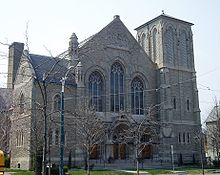 |
| CHUM-City Building CHUM-City Building 299 Queen Street West, also known as Bell Media Queen Street, is an office and studio complex located at the intersection of Queen Street West and John Street in Downtown Toronto, Ontario, Canada. Currently the corporate head office of Bell Media the building previously served as the headquarters... |
Commercial | 1911 |  |
| Burwash Hall Burwash Hall Burwash Hall is the second oldest of the residence buildings at Toronto's Victoria College. Construction began in 1911 and was completed in 1913. It was named after Nathanael Burwash, a former president of Victoria. The building is an extravagant Neo-Gothic work with turrets, gargoyles, and... |
University | 1911 | 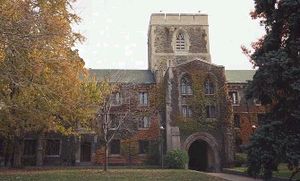 |
| Casa Loma Casa Loma Casa Loma is a Gothic Revival style house in midtown Toronto, Ontario, Canada, that is now a museum and landmark. It was originally a residence for financier Sir Henry Mill Pellatt. Casa Loma was constructed over a three-year period from 1911–1914. The architect of the mansion was E. J... |
Residential | 1911 |  |
| Knox College Knox College, University of Toronto Knox College is a postgraduate theological college of the University of Toronto in Toronto, Ontario, Canada. It was founded in 1844 as part of a schism movement in the Church of Scotland following the Disruption... |
University | 1914 |  |
| Deer Park United Church Deer Park United Church Deer Park United Church began in 1881 as Deer Park Presbyterian Mission, and the first building was constructed on the northwest corner of Yonge Street and St Clair, now presently home of an office tower containing a few radio stations, including CFRB, 99.9 Mix FM and 97.3 EZ Rock. In 1913, a... |
Church | 1913 | 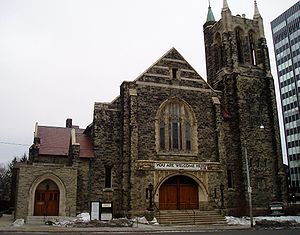 |
| Hart House | University | 1919 |  |
Guelph
| Building | Function | Year | Image |
|---|---|---|---|
| Church of Our Lady Immaculate Church of Our Lady Immaculate, Guelph Church of Our Lady Immaculate is a Roman Catholic church located in Guelph, Ontario, Canada designed by Joseph Connolly. It is considered Connolly's best work. To serve a Roman Catholic parish of predominantly German settlers this Gothic style-church was built between 1875 and 1883... |
Church | 1846 |  |
Saskatoon
| Building | Function | Year | Image |
|---|---|---|---|
| College Building College Building (Saskatchewan) College Building is a National Historic Site of Canada which is part of the University of Saskatchewan . The U of S is the largest education institution in the Canadian province of Saskatchewan... |
University | 1913 | 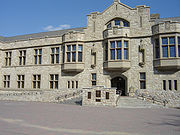 |
| Thorvaldson Building | University | 1924 |  |
Edmonton
| Building | Function | Year | Image |
|---|---|---|---|
| First Presbyterian Church First Presbyterian Church (Edmonton) First Presbyterian Church, located at 10025-105th Street is an historic Presbyterian Church in Canada congregation and Gothic Revival church building in downtown Edmonton Alberta Canada... |
Church | 1912 | 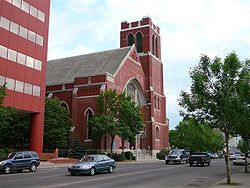 |
| Robertson-Wesley United Church Robertson-Wesley United Church Robertson-Wesley United Church is a church located a short distance west of the downtown core of the city of Edmonton, Alberta, Canada in the neighbourhood of Oliver.... |
Church | 1913 |  |
Vancouver
| Building | Function | Year | Image |
|---|---|---|---|
| Holy Rosary Cathedral Holy Rosary Cathedral (Vancouver) Holy Rosary Cathedral is a Roman Catholic cathedral in Vancouver, British Columbia. It is operated by the Roman Catholic Archdiocese of Vancouver; its Archbishop is J. Michael Miller, CSB and its Rector is the Very Rev. Glenn Dion... |
Church | ||
| Point Grey Secondary School Point Grey Secondary School Point Grey Secondary School is an 8-12 secondary school located in the Kerrisdale and Shaugnessy neighbourhood of Vancouver, British Columbia, Canada. The main building was built in 1929 in a Collegiate Gothic style. Construction of the school was commissioned by the Municipality of Point Grey... |
School | 1929 |  |
| St. George's School St. George's School (Vancouver) St. George's School , of Vancouver, Canada is an independent boarding and day university-preparatory school for boys.-History:... |
School | 1930 |  |
| Chemistry Building, UBC University of British Columbia The University of British Columbia is a public research university. UBC’s two main campuses are situated in Vancouver and in Kelowna in the Okanagan Valley... |
School |  |
See also
- Gothic Revival architectureGothic Revival architectureThe Gothic Revival is an architectural movement that began in the 1740s in England...
- Canadian architectureCanadian architectureThe architecture of Canada is, with the exception of that of Canadian First Nations, closely linked to the techniques and styles developed in Canada, Europe and the United States...
- List of Gothic Revival architecture

